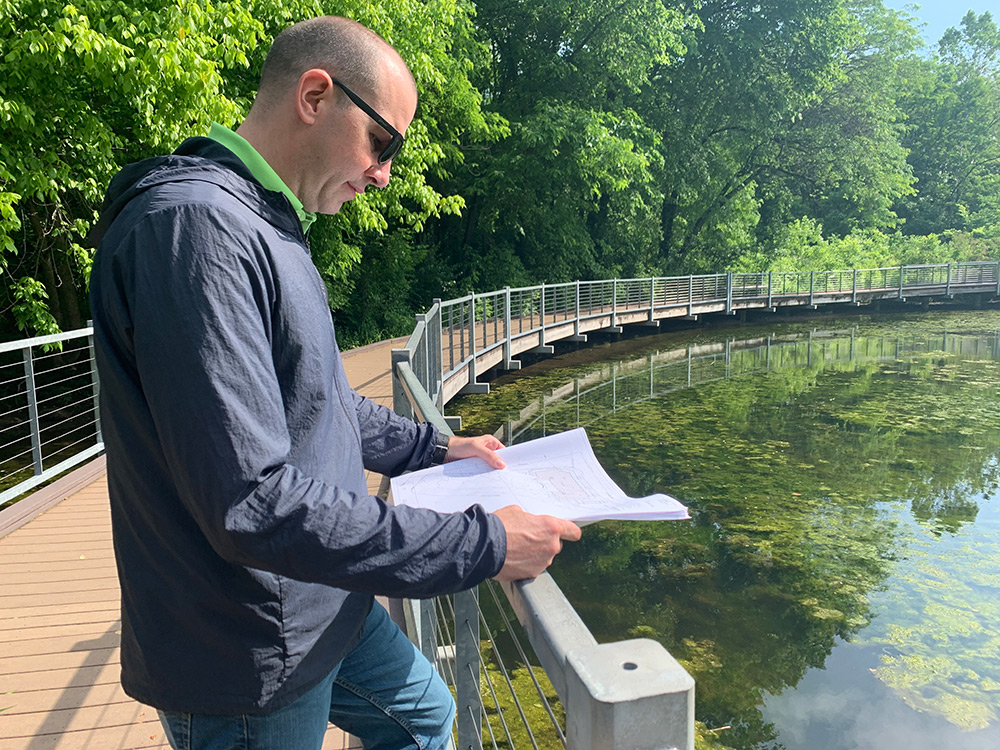Digging Into Landscaping
All of us enjoy spending time in outdoor spaces. For many, it can be a welcome retreat from a hectic and stressful workday, a peaceful oasis in which to unwind. Many of our most memorable experiences, even on vacations, often take place out of doors. In the ever-increasing business of everyday life, having access to the outdoors and nature, including planned green spaces, are becoming more important than ever. But how many of us really pay attention to our own outdoor spaces? How do you even begin to create an outdoor space that can very well be your sanctuary after a demanding day? Turning to a professional landscape architect can be the solution. They understand how to create a space that integrates nature with man-made structures.
We caught up with Tyler Dixon, a professional landscape architect with Carman Landscape Architecture with offices in Lexington and Louisville Kentucky. He has been a Landscape Architect for 5 years. As a landscape architect, he needs to listen to his client’s needs, and transform those needs into beautiful spaces that are also functional. He has worked on everything from private residences to city master plans, and everything in between. From early childhood facilities to college campuses, bourbon distilleries, and city parks, the focus is really on the client and the project at hand and providing the highest level of service.
What does your job entail?
We shape outdoor environments, including grading and drainage, utility coordination, circulation (both pedestrian & vehicular), hardscapes, and planting plans. We work closely with clients, contractors, architects, and other project team members, contractors, and stakeholders to facilitate the realization of a project from concept through the completion of construction.
How did you end up in the profession?
During my second year of college as an engineering major, I decided the path I'd chosen wasn't for me. At the time, I had never heard of landscape architecture, until a peer told me about the program. I did my research and quickly became attracted to the profession. I became sold on the design process approach to problem-solving, utilizing both creative/artistic and technical thinking skills. I scored well on the entrance exam and switched majors the following semester.
What is the most rewarding thing about your job?
There are several things that come to mind. It's rewarding to see the transformation of underutilized space to a successful, functional space. Practicing social and environmental stewardship through design is also rewarding. The biggest rewards are from helping others resolve a problem, whatever that may be. Whether it is an individual or a community, if you have changed someone's quality of life for the better, that's a pretty amazing thing.
What is challenging?
Each site and project brings its own unique challenges. There's very little monotony, it's what I love about the profession.
What was one of the biggest or most involved designs you have ever done?
Our level of involvement can vary from one project to the next. Typically, larger projects require more design disciplines and have more stakeholders to consider, which requires more frequent communication and coordination. For example, any of our campus projects may have an extensive board of representatives from the university engaging with the design team during all design and construction phases. These projects often require a detailed schedule considering the optimal phasing of work so as to not interfere with the student's daily routines while on campus.
What advice do you have for someone taking on a project?
Formulate a plan. Successful outdoor spaces begin with a detailed plan. A comprehensive design of a landscape should consider all of the components of the existing site and the needs and preferences of the stakeholders. Landscapes are experienced by the user not just visually but physically and psychologically too, so it's important to keep that in mind throughout planning and design. Whether it's residential, commercial, institutional, or civic, projects can vary greatly in size and scope. If the project seems overwhelming a design professional such as a landscape architect can help alleviate some of the stress by providing guidance throughout the design process, assisting in the selection of a contractor, and managing the project during construction.
What kind and why are boots important?
Much like design, you should not sacrifice quality, comfort, safety, or aesthetics for one another. As a former bartender, I have spent long hours on my feet and have always been an advocate for quality footwear. As a landscape architect, both comfort and safety are paramount whether I'm in the field or on a job site.







